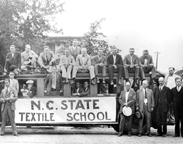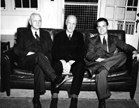| Index |
| Introduction |
| Early History |
| Recent History |
| Credits |
| Exhibits |
| Special Collections |
| NC State University Libraries |
Early History
|
Minutes
of the Board of Trustees from 2 August 1899.
|
D. A. Tompkins of Charlotte was one of the most eager advocates for textile education in the South. Tompkins and other community leaders were instrumental in the founding of the textiles department in 1899 at the North Carolina Agricultural and Mechanical College (NC State University). George Franks Ivey taught the first course in textiles in 1899. The next year the college expanded its textiles program; Ivey left and Henry M. Wilson joined the faculty as an instructor in cotton manufacturing. The college offered courses such as carding and spinning, weaving, textile designing, and textile chemistry and dyeing. The courses provided students with specialized expertise to operate mills and use advanced scientific research in the textiles industry.
|
A
page from Albert Grimshaw's thesis Microscopic Research of Factors
Varying Penetration of Dyes on Rayons and Kindred Fibres.
|
 |
|
NC
State students go on a field trip. Thomas Nelson is the second from the
right, front row.
|
The original textile equipment was housed in the basement of Holladay Hall. Support for the program grew, and in 1901 the North Carolina General Assembly appropriated $10,000 toward the construction of a textile building. This structure, Tompkins Hall, resembled a textile mill of the period and was completed in early 1902. Thomas Nelson, a young Englishman from the Lowell Textile School in Massachusetts, joined NC State's faculty in 1901 and became department head in 1906 following Wilson's resignation.
|
Tompkins Hall Before and during the fire of 1914 |
 |
|
Thomas Nelson, center |
On 24 March 1914 Tompkins Hall was almost completely destroyed by fire. With the help of builders and manufacturers, who donated much of the replacement machinery, the textiles program bounced back and by 1919 enrollment reached 154. Meanwhile, the textile industry continued to expand in North Carolina, as mills from the North moved South. The new College of Textiles (School of Textiles) was created out of the School of Engineering at the Board of Trustees meeting on 8 June 1925 and Thomas Nelson was appointed dean of the school.
|
Cover
of an Annual Report from the Textile School for 1935
|
|
Textile Exposition and Style Show 10-11 April 1929 Left to Right: Betsy Lee, Second Prize, St. Mary's; Carolyn Tucker, First Prize, St. Mary's; Montrose Mull, Second Prize, Peace Institute; Mary C. White, First Price, Peace Institute; Elsie Brown, Second Prize, Meredith College; Lelia Nolan, First Prize, Meredith College; and Grace Jolly, Grand Prize Meredith College. |
From 1925 to 1943 students organized style shows to display their fabric designs. Students from local women's colleges participated in the event by creating fashions from fabrics made by NC State students and by modeling for the shows. These popular style shows were held in Pullen Hall. After the show, the audience and contestants visited Tompkins Hall to attend the NC State College Textile Exposition which displayed the latest methods of textile processing from raw material to finished fabrics.